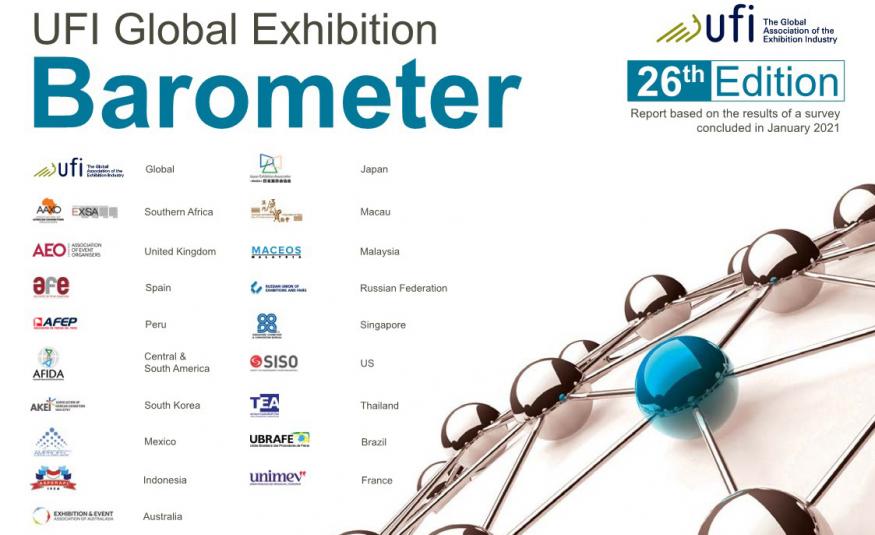UFI, the global association of the exhibition industry, is predicting industry revenues will double in 2021 compared to 2020 and a quick recovery for the sector. The confidence comes from the publication of the association’s latest UFI Global Barometer which provides 2020 results and 2021 perspectives for the exhibition industry based on input from 457 industry companies across 64 countries and regions.
The Barometer, released on 26 January, acknowledges the challenge thrown up by the pandemic over the past year, with over half (54%) of all companies surveyed saying they have had to reduce their workforce over the period, half of them said the cut was more than 25%.
The doubling of revenues expected in 2021 compares to a 2020 figure that represented just 28% of 2019 revenues.
Still, 64% of all surveyed say they are confident that Covid-19 has reinforced the value of face-to-face events, and that the sector will recover quickly.
The full research provides dedicated profiles for 29 separate markets and regions and enables a host of comparisons to be made.
Digging deeper into the new data, the Barometer shows that globally, between April and August 2020, more than half of all companies reported no activity. This situation changed from September, where the majority of companies declared some operations, at reduced levels for most. The survey found that 37% of companies are expecting activity to be ‘normal’ already in June 2021.
The results do vary depending on region, and are primarily driven by the ‘re-opening date’ of exhibitions. In all regions, most companies expect both local and national exhibitions to re-open by the end of June 2021, with international exhibitions resuming in the second half of the year.
When asked what element would most help with the ‘bounce back’ of exhibitions, the majority of companies ranked ‘Readiness of exhibiting companies and visitors to participate again’ (64%), ‘The lifting of current travel restrictions’ (63%) and ‘The lifting of current public policies that apply locally to exhibitions’ (52%) as key factors.
Overall
The Barometer found that overall 44% of companies benefitted from some level of public financial support, although for the majority this related to less than 10% of their overall 2019 costs.
Ten percent of companies say they will have to consider permanently ceasing operations if there are no events for the next six months, however.
As expected, the ‘impact of the Covid-19 pandemic on the business’ is considered the most important business issue (stated by 29% of companies, a 2% increase on six months ago). The ‘impact of digitalisation’ (11%) and ‘competition with other media’ (7%) have also increased (+1% and +2% respectively), while the ‘state of the economy in the home market’ (19%) and ‘global economic developments’ (16%) have decreased, but remain among the top three concerns.
In terms of future exhibition formats, global results indicate that 64% (compared to 57% in the Barometer six months ago) are confident that ‘Covid-19 confirms the value of face-to-face events’ indicating an expectation that the sector will bounce back quickly.
“We will ‘build back’ even better, and while the industry will remain, primarily, a face-to-face marketing channel, digital offers will evolve with new patterns,” commented Kai Hattendorf, UFI managing director and CEO.
The UFI Global Barometer study for the first time welcomed as research partners the Peruvian association AFEP and UNIMEV from France. They helped produce the Barometer's first ever specific country profiles for Peru and France, noted Christian Druart, UFI research manager.
Turnover – operating profits
Among the regional results catching the eye, the revenue drop for 2020 was the highest for companies in Central and South America and the Middle East and Africa (who respectively only achieved 23% and 24% of 2019 revenue levels). Companies in Europe (32% of 2019 levels) and North America (36% of 2019 levels) were at the other end of the scale.
The 2021 perspectives are rather similar for all regions: who are expecting to achieve between 32% and 37% of last year’s revenue for H1- 2021, and between 55% and 60% for all of 2021.
The share of companies who faced a loss for 2020 varies from 47% in the Asia-Pacific region and Europe, to 50% in North America, 58% in the Middle East and Africa, and 64% in Central and South America.
Public financial support and workforce
Regional results indicate that:
The number of companies receiving public financial support is higher in Europe (54% of companies) and the Asia-Pacific region (53%), than in Central and South America (35%), North America (31%) and the Middle East and Africa (13%).
The share of companies forced to reduce their workforce is higher in the Middle East and Africa (73% of companies), North America (61%) and Central and South America (56%), than in Europe (52%) and the Asia-Pacific region (49%).
The proportion of companies believing they will need to close if business doesn’t resume within the next six months varies from 5% in North America and 6% in the Asia-Pacific region, to 17% in the Middle East and Africa.
Future exhibition formats
The report also highlights two significant regional differences in relation to possible trends driving the future format of exhibitions:
The claim ‘Covid-19 confirms the value of face-to-face events’ was more widely agreed with in the Middle East and Africa (70% of companies), the Asia-Pacific region (69%) and Europe (67%), than in North America (55%) and Central and South America (53%).
While, there were stronger opposing views for the claim ‘virtual events are replacing physical events’, with 74% of companies in Europe disagreeing, compared to just 57% of companies from North America.
The 26th Global Barometer survey was conducted in December 2020 in collaboration with 20 UFI member associations. The full results can be downloaded at www.ufi.org/research The next UFI Global Barometer survey will be conducted in June 2021.





